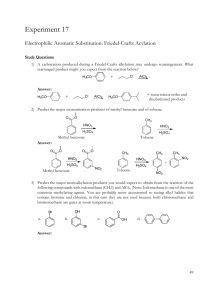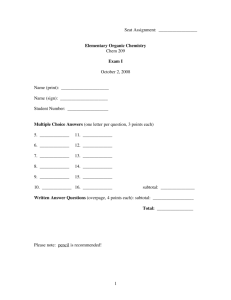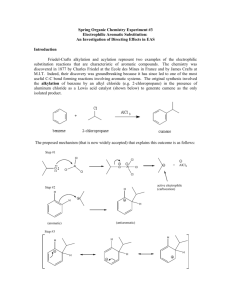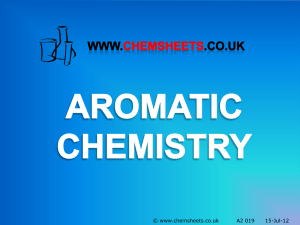24.6 Sources of Phenols
advertisement
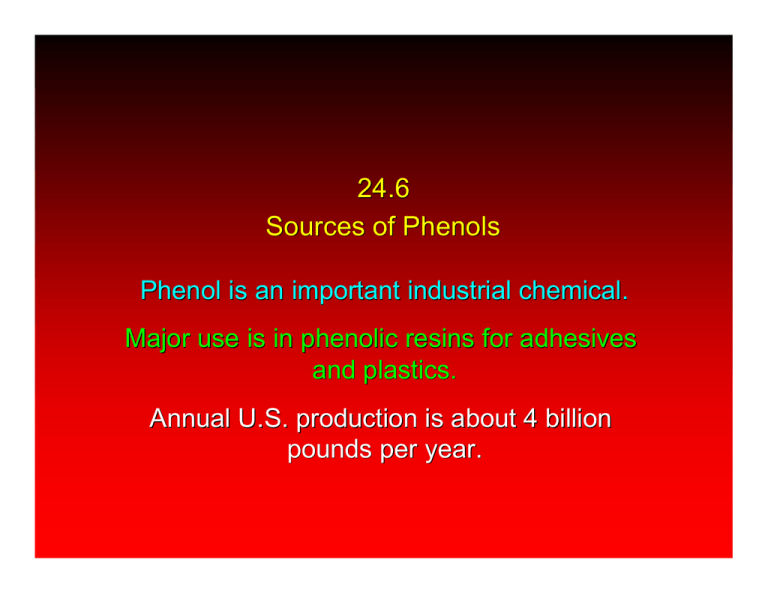
24.6 Sources of Phenols Phenol is an important industrial chemical. Major use is in phenolic resins for adhesives and plastics. Annual U.S. production is about 4 billion pounds per year. Industrial Preparations of Phenol SO3H Cl 1. NaOH 2. H+ heat 1. NaOH heat 2. H+ OH CH(CH3)2 1. O2 2. H2O H2SO4 Laboratory Synthesis of Phenols from arylamines via diazonium ions O 2N NH2 1. NaNO2, H2SO4, H 2O O 2N OH 2. H2O, heat (81-86%) 24.7 Naturally Occurring Phenols Many phenols occur naturally Example: Thymol OH CH3 CH(CH3)2 Thymol (major constituent of oil of thyme) Example: 2,5 -Dichlorophenol OH Cl Cl 2,5-Dichlorophenol (from defensive secretion of a species of grasshopper) 24.8 Reactions of Phenols: Electrophilic Aromatic Substitution Hydroxyl group strongly activates the ring toward electrophilic aromatic substitution Electrophilic Aromatic Substitution in Phenols Halogenation Nitration Nitrosation Sulfonation Friedel-Crafts Alkylation Friedel-Crafts Acylation Halogenation OH OH + Br2 ClCH2CH 2Cl 0°C Br (93%) monohalogenation in nonpolar solvent (1,2-dichloroethane) Halogenation OH OH + 3Br2 F H 2O Br Br 25°C F Br (95%) multiple halogenation in polar solvent (water) Electrophilic Aromatic Substitution in Phenols Halogenation Nitration Nitrosation Sulfonation Friedel-Crafts Alkylation Friedel-Crafts Acylation Nitration OH OH N O2 HNO3 acetic acid 5°C CH3 OH group controls regiochemistry CH3 (73-77%) Electrophilic Aromatic Substitution in Phenols Halogenation Nitration Nitrosation Sulfonation Friedel-Crafts Alkylation Friedel-Crafts Acylation Nitrosation NO OH OH NaNO2 H2SO4, H2O 0°C (99%) only strongly activated rings undergo nitrosation when treated with nitrous acid Electrophilic Aromatic Substitution in Phenols Halogenation Nitration Nitrosation Sulfonation Friedel-Crafts Alkylation Friedel-Crafts Acylation Sulfonation OH H 3C OH CH3 H2SO4 H 3C CH3 100°C SO3H OH group controls regiochemistry (69%) Electrophilic Aromatic Substitution in Phenols Halogenation Nitration Nitrosation Sulfonation Friedel-Crafts Alkylation Friedel-Crafts Acylation Friedel-Crafts Alkylation OH OH CH3 CH3 (CH3)3COH H3PO4 60°C H 3C (CH3)3COH reacts with H3PO4 to give (CH3)3C+ C CH3 CH3 (63%) Electrophilic Aromatic Substitution in Phenols Halogenation Nitration Nitrosation Sulfonation Friedel-Crafts Alkylation Friedel-Crafts Acylation 24.9 Acylation of Phenols Acylation can take place either on the ring by electrophilic aromatic substitution or on oxygen by nucleophilic acyl substitution Friedel-Crafts Acylation OH OH O CH3CCl + ortho isomer AlCl3 under Friedel-Crafts conditions, acylation of the ring occurs (C-acylation) O C CH3 (74%) (16%) O-Acylation O OH OC(CH2)6CH3 O + CH3(CH2)6CCl (95%) in the absence of AlCl3, acylation of the hydroxyl group occurs (O -acylation) O- versus C -Acylation O OH OC(CH2)6CH3 AlCl3 C formed faster CH3 O more stable O-Acylation is kinetically controlled process; C-acylation is thermodynamically controlled AlCl3 catalyzes the conversion of the aryl ester to the aryl alkyl ketones; this is called the Fries rearrangement 24.10 Carboxylation of Phenols O Aspirin and the Kolbe-Schmitt Reaction OCCH3 COH O Aspirin is prepared from salicylic acid O O OH COH CH3COCCH3 H2SO4 O how is salicylic acid prepared? O OCCH3 COH O Preparation of Salicylic Acid ONa CO2 125°C, 100 atm OH CONa O called the Kolbe-Schmitt reaction acidification converts the sodium salt shown above to salicylic acid What Drives the Reaction? acid -base considerations provide an explanation: stronger base on left; weaker base on right •• •– O• •• + •• O H C •• – O •• •• •• CO2 •• O • • stronger base: pKa of conjugate acid = 10 weaker base: pKa of conjugate acid = 3 Preparation of Salicylic Acid ONa CO2 125°C, 100 atm OH CONa O how does carbon-carbon bond form? recall electron delocalization in phenoxide ion negative charge shared by oxygen and by the ring carbons that are ortho and para to oxygen – •• •O • • • H •• •O • H H – H •• H H H H H •• •• •O • •O • H H – H H H H H •• H H •• – H H Mechanism of ortho Carboxylation •• •• O •• – O •• C •• H O •• •• •• • O• C H •• •– O• •• •• O • • Mechanism of ortho Carboxylation •• •• O •• – O •• C •• •• • O• O •• •• C H H •• O H C •• •– O• •• •• •• O • • •• •– O• •• •• O • • Why ortho? Why not para? •• O H C •• – O •• •• •• •• O • • •• •– O• •• •• O •• –• •• •O •• C •• O • • H Why ortho? Why not para? •• O H C •• – O •• •• •• •• O • • weaker base: pKa of conjugate acid = 3 •• •– O• •• •• O •• –• •• •O •• H C •• O • • stronger base: pKa of conjugate acid = 4.5 Intramolecular Hydrogen Bonding in Salicylate Ion O H C O– O Hydrogen bonding between carboxylate and hydroxyl group stabilizes salicylate ion. Salicylate is less basic than para isomer and predominates under conditions of thermodynamic control.

